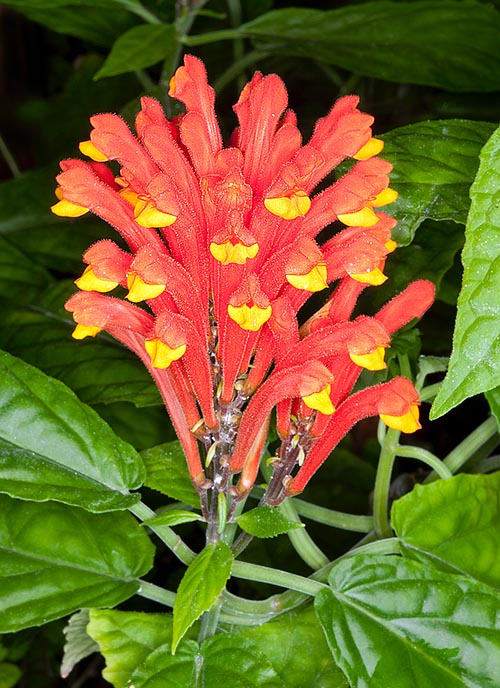Family : Lamiaceae

Text © Pietro Puccio

English translation by Mario Beltramini

The Scutellaria costaricana inflorescences have 6 cm corollas © Giuseppe Mazza
The name of the genus comes from the Latin “scutella” = bowl, cup, with reference to the shape of the calyx; the Latin name of the species “costaricana” = of Costa Rica, Costa Rican, refers to one of its places of origin.
Common names: bladdersage, helmet flower, scarlet skullcap, Costa Rican skullcap (English); escutelária (Portuguese).
The Scutellaria costaricana H.Wendl. (1863) is an evergreen herbaceous species, up to more than 1 m tall, with dark purple erect stems with section almost quadrangular and dark green leaves, on a 2-4 cm long petiole, opposite, ovate, deeply veined, 8-15 cm long and 3-6 cm broad, with serrate-dentate edge and pointed apex.
Racemose terminal inflorescences, 5-8 cm long, carrying flowers with bilabiate campanulate calyx and tubular corolla, of scarlet red colour with yellow fauces, pubescent and slightly bent forward, about 6 cm long, bilabiate, with convex and tri-lobed lower labium, and 4 stamina. It reproduces by seed, but rarely fructifies outside from the origin areas, and by herbaceous cutting, in spring, in sandy soil kept humid at the temperature of 24-26 °C.
It is the most diffused species in cultivation of the genus Scutellaria due to the ornamental foliage and the long-lasting showy flowering, as garden plant, in the tropical and subtropical climate zones, and also in pot, where the open air cultivation is not possible along the whole year, for the decoration of patios and balconies in summer and verandas and greenhouses in winter.
In the garden, utilized in group or for borders, it requires a full sun exposition, excepting the central hours of the day, or slight shade, and draining soil, rich of organic substance, acidic or neutral, kept humid. It stands the prunings, to be done by the end of winter, which foster its tufting. In pot, it is to be cultivated in an as much as possible luminous position in organic soil, acidic or neutral with addition of coarse siliceous sand or agri-perlite for improving the drainage, with lowest winter temperatures preferably over the 15 °C.
Waterings must be regular in summer, reduced in winter, but without allowing the substratum to dry up completely, avoiding water stagnations which may cause rottenness; it requires a high ambient humidity, useful are the nebulisations with not calcareous water in order to avoid unaesthetic dots on the leaves, if the location is warm and dry. It is quite subject to attacks by mites and aphids, which are to be treated with specific products.
They have selected numerous varieties of different colours, yellow, pink, white, orange, in various shades.
→ To appreciate the biodiversity within the family LAMIACEAE please click here.
